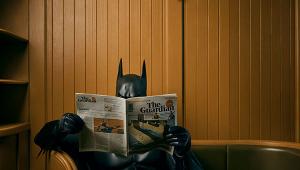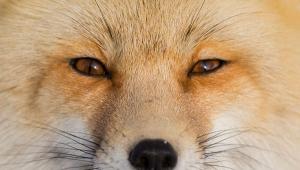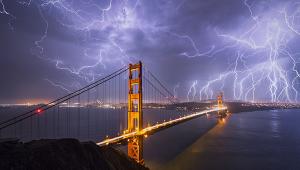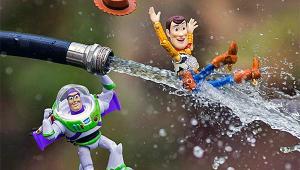On The Edge: Photographer Scott Serfas' Tips for Capturing Nail-Biting Action

Red Bull Joyride is the biggest slopestyle mountain-bike event of the year, which takes place at Crankworx Whistler Freeride Mountain Bike Festival. “You position yourself to shoot two or three different features, never knowing what will happen. In this instance, the rider missed a jump that he usually made, but he got back up and this time succeeded. I found the perfect spot, waited for the chairs, and grabbed the shot as he reached the apex of his jump between them.” Technical info: Canon EOS-1D Mark IV, EF 70-200mm f/2.8L IS; ISO 800, f/8, 1/1000 second.
All Photos © Scott Serfas
Scott Serfas is one photographer who likes to get in on the action. In fact, he thrives on it. There is a certain amount of serendipity involved, but there is also a certain amount of passive control, in the sense that Serfas knows what to expect and expects the unexpected.
“I primarily photograph sports that I enjoy doing myself,” Serfas observed. “I’m personally involved in snowboarding, skateboarding, surfing, and mountain biking. More recently, working with Red Bull I’ve been able to shoot sports that I don’t do or no longer participate in, such as BMX (bicycle motocross), which I did as a kid.”
But does Serfas consider this “extreme”? “I don’t really call it ‘extreme sports.’ The word ‘extreme’ is used way too often. The guys that I’m shooting are on the top of the sport, and most of what they’re doing is extreme. However, I prefer to call it ‘action sports.’”

“This was for a project that we called ‘Last Resort.’ There was an abandoned, partially built resort hotel located on the east coast of Canada. With access to the property for a week, we built a ramp and positioned an HMI outside to simulate sunlight, aided by a smoke machine on the inside to help capture the rays of light. I had to wait for a video crew to finish shooting before I could capture this moment.” Technical info: Canon EOS-1D X, EF 24-70mm f/2.8L II; ISO 2500, f/3.2, 1/250 second.

“We were promoting Brandon Semenuk’s film Rad Company, which focuses on freeride mountain biking. Shooting hand-held, which is how I normally work, I found a vantage point that would reflect the bike in the water as it was sailing through the air and captured a rapid sequence that was stitched into the water below. I had to watch his body language to be prepared for the shot because I didn’t know if or when he would actually hit the jump. It’s all about timing for me and the rider.” Technical info: Canon EOS-1D X, EF 24-70mm f/2.8L II; ISO 2500, f/5, 1/1000 second.
Doing What He Loves
Capturing the action was a natural extension of being in the action for Serfas. “I got started shooting friends on weekends,” he recalled. “We’d go skiing or snowboarding, and we always had a camera with us so we could take pictures of each other. This was in the mid to late ’80s. Snowboarding was still new and some areas forbade it at the time. As it grew, the guys I knew started getting sponsors and becoming professional snowboarders. They needed pictures, so I was the one who would take them. So as they were improving in their sport, I was improving with the camera.”
Serfas started with his mom’s Kodak Instamatic and moved up to his dad’s fully manual Minolta SLR. “I was shooting negative color film. One of the sponsors wanted to buy a shot and said, ‘If you had shot this on slide film, we could have used it and paid you $100.’ I said, ‘You’re actually going to give me money for this, because I’m having a great time shooting it?’ I was 18 or 19 at the time and getting paid for this was something I didn’t know was possible. So I switched to slide film from that point forward, and was also forced to learn how to control the camera. After that, the work mushroomed with the increasing popularity of snowboarding as a sport.”

“What I like about this shot is that you have one wave coming in, the other going out, creating that funky lip. I’m on the back of a jet ski with the camera safely housed.” This was shot in Mexico. Technical info: Canon EOS 5D Mark III, EF 70-200mm f/2.8L IS; ISO 200, f/5.6, 1/1000 second.

“The camera, in a housing, was half in the water and half out. I had wanted to do a shot like this for some years, and, as luck would have it, all the pieces came together at this location. The trout were added to the river and, of the numerous attempts at capturing the moment, this one shot also included a very cooperative trout staring into the camera.” The park crew assisted with building a quarter pipe and a pond at the top, with the Fisheries Department supplying the trout. Serfas focused on the snowboarder. “I fired one light into the water, on the fish, and two or three lights on the snowboarder.” Shot in Big Bear, California. Technical info: Canon EOS 5D Mark II, EF 15mm f/2.8 Fisheye; ISO 200, f/18, 1/250 second.
Taking A Leap
If, for whatever reason, he didn’t succeed as a professional photographer, Serfas had an exit strategy. Lucky for him, his leap of faith paid off.
“Right after high school I’d decided to become a plumber’s apprentice, so I’d have a trade in case photography didn’t work out. Fortunately, it did, because I wasn’t thrilled with plumbing. Whenever there was a lot of snow, I’d call in sick and head for Whistler Mountain to ride and shoot pictures.
“At one point, we’d hiked Mount Seymour and built snowboard jumps with Vancouver in the background. That sparked a growing interest in shooting there. It was then that I realized that I didn’t need another job—this was paying the bills.” That was in the early 1990s.
Working with the Minolta taught Serfas about timing: “You had to choose the right moment to shoot.” After a few years and seeing what a friend’s motor-driven camera could do, he switched to a Canon motor-driven SLR. He finally made the jump to digital—a Canon EOS-1D, in 2005, having been hesitant to take the plunge. He now primarily uses a 1D X, notably for its ability to capture rapid-action sequences. He processes the images in Lightroom.
“I’m about getting quality action. I want to make sure that the person in the shot is happy with it and I want to make sure that my photographs legitimize what that person is doing. And if I can add an artistic aspect or a creative angle, then that’s great.”
When it comes to exposure, “I determine how fast they’re going to be moving.” But it’s not all available light. Far from it. Where needed, Serfas uses flash to make the athlete pop out of the scene. When time and location permit, he’ll opt for a Profoto Pro-7b. In tight situations, the flash of choice is a Sunpak 555 handle mount, which has proved popular in skateboarding circles (he picks these up on eBay when they become available).

Travis Rice is featured here, for the snowboarding film, The Art of Flight. There were two helicopters, one for the film crew, the other carrying Serfas. “It was the last day available to me and the light was fading. It became a do-or-die situation. I shot this just as the film crew helicopter had completed a few turns around the mountain.” The vignetting is natural to a point, but manually emphasized. Technical info: Canon EOS-1D X, EF 24-70mm f/2.8L II; ISO 1000, f/5.6, 1/1250 second.

This is also from The Art of Flight, this time featuring snowboarder John Jackson. “I had no idea how big this jump would be because I only saw it from the top and couldn’t see the crevice. I found an angle that kept me out of view of the aerial shots. He hit the jump four times and did a different trick every time. This is a backside 1080 double cork. I shot a fast sequence, which was later composited into a single frame to create a stroboscopic effect, thereby giving you a true feel for the jump.” Technical info: Canon EOS-1D Mark IV, EF 70-200mm f/2.8L IS; ISO 400, f/5.6, 1/1000 second.
Toughing It Out
Serfas often works under Arctic-like conditions when shooting on a mountain or in freezing cold water in the ocean (despite wearing a wetsuit—even in summertime). In the water he’ll employ an AquaTech housing (aquatech.net).
“Half the fun is avoiding injuries. Knowing the sport certainly helps. So does knowing what the athletes plan to do, and, if they make a mistake, knowing where they could end up, so you can prepare yourself to be clear of the action.
“In snowboarding, generally you’re a little further away, but often you’re working in avalanche conditions. If they land and the whole face of the mountain slides, is your bag zipped up and on your back, do you have your snowboard on and ready to move and find a safe spot? Lots of different things to consider in very little time.”
Skateboarding has its own inherent risks. “A lot of times if I’m shooting skateboarding with a fisheye, I’ll set up the camera angle, hold the camera in one hand, move my face away, and use my other hand to block anything that comes at me.”
As the popularity of a particular sport increases, so do the various locations that Serfas shoots in. “Now, it’s more about getting to places where no one’s been, getting to unique spots to shoot the action for myself and my clients.”
Scott Serfas is based in Whistler, British Columbia, Canada. His action shots keep you on the edge of your seat. Go along for the ride by visiting scottserfas.com.

“Drew Bezanson’s idea was to do a freestanding wall ride on his BMX bike, jumping from these elevated cargo containers. He practiced the move first at ground level, and then took it to the extreme at this full height. I’m on a scissor lift about 65 feet up.” Technical info: Canon EOS-1D X, EF 70-200mm f/2.8L IS; ISO 4000, f/4, 1/800 second.
His Favorite Lens
“I’d have to say the Canon 15mm fisheye is my favorite lens,” Serfas said. “I hold the camera crooked when using that lens to help reduce the look of distortion. In a way, with this lens you become part of the shot, not a distant observer documenting a scene. It adds a lot more excitement to the shot.”

What’s In Serfas’s Gear Bag
* Canon EOS-1D X
* Canon EOS 5D Mark II
* Canon EF 15mm f/2.8 Fisheye
* Canon EF 24-70mm f/2.8
* Canon EF 70-200mm f/2.8
* Canon EF 300mm f/4
* Leica M9 with 35mm f/1.2
* F-stop photo backpack (owns several sizes)
* Baofeng UV-5RA Dual Band Portable Radio (+2 backups)
- Log in or register to post comments

















































